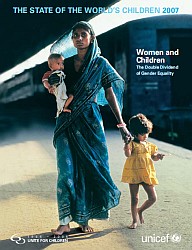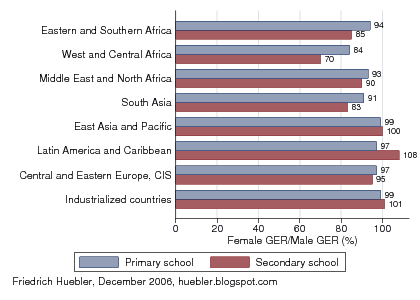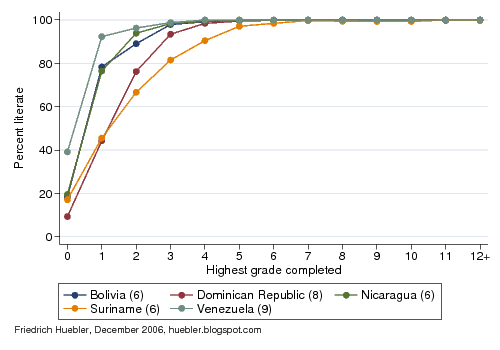 On 11 December 2006, UNICEF released the 2007 edition of its annual publication The State of the World's Children. This year's report, with the title Women and children: The double dividend of gender equality, looks at the status of women today and discusses how gender equality can help achieve the UN Millennium Development Goals.
On 11 December 2006, UNICEF released the 2007 edition of its annual publication The State of the World's Children. This year's report, with the title Women and children: The double dividend of gender equality, looks at the status of women today and discusses how gender equality can help achieve the UN Millennium Development Goals.The report argues that gender equality produces a double dividend because it benefits both women and children. Healthy, educated and empowered women have healthy, educated and confident children. Through gender equality women can not only live full and productive lives, they can also improve the lives of their children, their families, and the society they are part of.
The State of the World's Children contains detailed statistical tables with data on health, nutrition, HIV/AIDS, education, demographics, economy, women, and child protection for each country. In the area of education, the report lists data for the following indicators:
- Literacy
- Primary school enrollment and attendance
- Secondary school enrollment and attendance
- Survival rate to grade 5
- Primary school gross enrollment rate (GER) = Number of children enrolled in primary school / Number of children of official primary school age
- Female GER as a percent of male GER = 100 * (Female GER / Male GER)
Note that the reported values contain no information about the absolute level of school enrollment. It is possible to have gender parity at very low enrollment levels. Take a country where 50 percent of boys and 50 percent of girls attend primary school. Although the country would be far from the Millennium Development Goal of universal primary education, there would be gender parity in primary school. For data on absolute enrollment levels refer to an earlier post on primary school enrollment in 2004, with the most recent data from the UNESCO Institute for Statistics.
Primary and secondary school gross enrollment ratios: female GER as a percent of male GER, 2000-2005

Data source: UNICEF. 2006. The state of the world's children 2007: Women and children - The double dividend of gender equality. New York: UNICEF. Table 8, page 133.
According to the data reported by UNICEF, only two regions have achieved gender parity in both primary and secondary school: East Asia and the Pacific, and the industrialized countries. The countries of Central and Eastern Europe and the Commonwealth of Independent States (CIS) are close to gender parity, with female enrollment rates at 95 to 97 percent of male enrollment rates. Latin America and the Caribbean are close to gender parity in primary school but in secondary school, the female GER far exceeds the male GER (gender parity index 108 percent), which means that more girls than boys continue their education past primary school.
In the Middle East and North Africa, the female GER is at 93 percent of the male GER in primary school and at 90 percent in secondary school. In the three remaining regions, there is a larger drop in the gender parity index from primary to secondary school. In Eastern and Southern Africa, almost as many girls as boys are enrolled in primary school (gender parity index 94 percent) but at the secondary level of education, the female GER is only 85 percent of the male GER. In South Asia, the gender parity index is 91 percent in primary school and 83 percent in secondary school.
In West and Central Africa, girls are furthest behind boys in terms of school enrollment. The gender parity index is 84 percent in primary school and 70 percent in secondary school. In addition, total enrollment rates are lower than in any other region of the world (see primary school enrollment in 2004 and primary school enrollment in 2002/03). Compared to boys and compared to girls in other region, girls from West and Central Africa are least likely to reap the benefits of a formal school education.
External links
- The State of the World's Children 2007 web site
- Download The State of the World's Children 2007 (PDF, 1.8 MB)
- UN Millennium Development Goals
- Primary school enrollment in 2004
- Primary school enrollment in 2002/03
- Trends in primary school enrollment, 1970-2004
- Primary school gross and net enrollment
Permanent URL: http://huebler.blogspot.com/2006/12/state-of-worlds-children-2007-by-unicef.html


